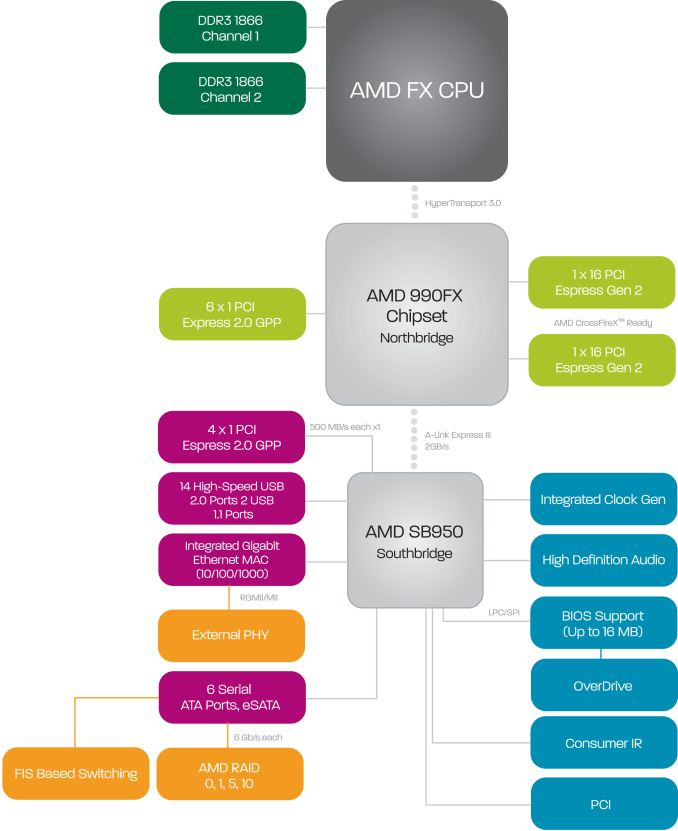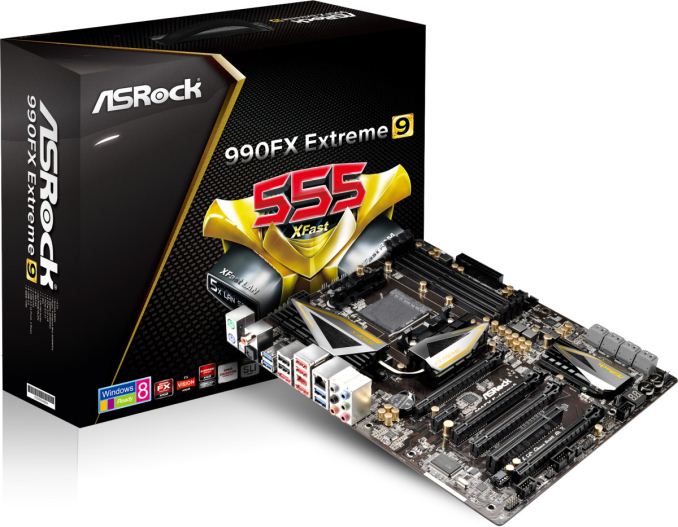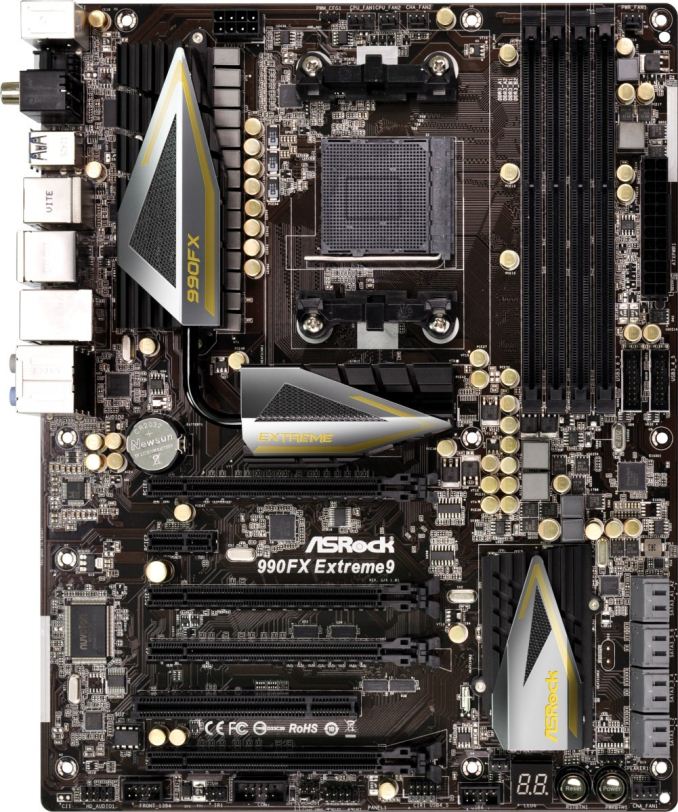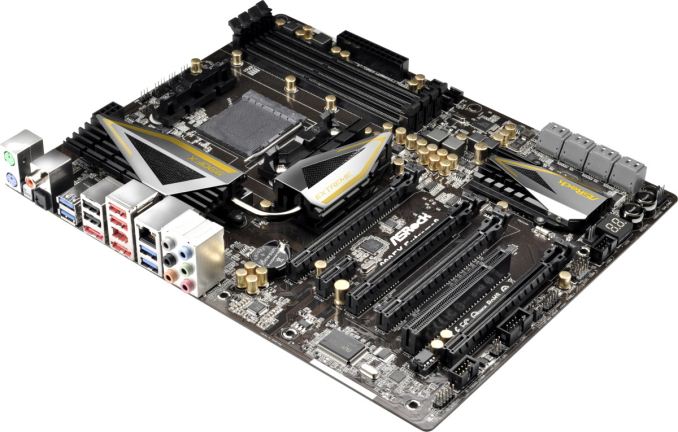AMD’s 5 GHz Turbo CPU in Retail: The FX-9590 and ASRock 990FX Extreme9 Review
by Ian Cutress on August 9, 2014 8:00 AM ESTFor new users to the PC industry, or those that migrated towards newer APU platforms, it is worth going back and recalling the AM3+ socket with the 990FX chipset. When the platform was released, it offered several advantages that Intel lacked at the time: a full set of SATA 6 Gbps ports was the main advantage which took Intel another two generations to offer. The chipset, with the right CPU, also offered substantially more PCIe lanes than the mainstream Intel parts which were similarly priced. While the user could have sixteen PCIe 2.0 lanes from an Intel CPU for graphics coupled with eight PCIe 2.0 lanes from the chipset, AMD users had 32 PCIe 2.0 lanes from the CPU for graphics, another six PCIe 2.0 x1 lanes for controllers and four PCIe 2.0 x1 lanes from the chipset. This gave the AMD motherboard manufacturers more bandwidth to add extra ports or adjust their PCIe layout for graphics. Note that this is the latest AMD platform to support SLI, rather than the newer FM1/FM2 platforms that do not.
There are a few limitations on the 990FX chipset worth mentioning. When this motherboard we are testing today was released, PCIe 3.0 was gaining momentum. The only way to add PCIe 3.0 to these motherboards was to integrate a PLX chip between the Northbridge and the GPUs which gave PCIe 3.0 capabilities between the GPUs, but it still limited data transfer between the PLX chip and the CPU to PCIe 2.0. The other limitation was one of cost. AMD platforms have historically been low cost markets, at least for end users, which correlates to a reluctance to expand spending on motherboards. This reduces the market for high end motherboard solutions which might incorporate extra features and controllers, and as a result many AM3+ motherboards were aimed at price/performance rather than feature set.
The ASRock 990FX Extreme9 sits near the top of the stack for feature set, and currently retails for $170. To put that into perspective, we discuss $170 motherboards for Intel’s latest chipsets as a mid-range point rather than the high end.
Also worth noting that because our last 990FX reviews were with the FX-8150 processor, in order to compare to historical data we also used the Extreme9 with the FX-8150 for comparison points.
ASRock 990FX Extreme9 Overview
Visual Inspection
Taking the motherboard out of the box for the first time and there are several items worth noting. Firstly the extended heatsink which covers the 12+2 phase power delivery to the side of the socket and the North Bridge just below the socket. ASRock has placed all the power delivery chokes in a line, and uses a CHIL8328 IC for a digital design. This PWM controller powers 6-8 phases, and thus the system uses multiplexing to get the desired 12 for the CPU voltage.
The socket area has four fan headers within immediate reach – two CPU and one chassis header directly above the socket, and a 3-pin PWR header to the top right of the DRAM slots. The other two fan headers on the motherboard are located at the bottom, one to the left of the 2-digit debug and the other to the right of the power/reset buttons. The socket area uses a low heatsink profile combined with a gap to the DRAM that should allow for large air coolers to be used.
The DRAM slots use double sided latch mechanisms and there is ample space to the first major PCIe slot. At the bottom of the DRAM slots, to the right, are two USB 3.0 headers from an Etron EJ188H controller. At the time this motherboard was made, a chassis may have had one USB 3.0 header, and thus ASRock also includes a USB 3.0 panel in the box.
Underneath this are eight SATA 6 Gbps ports, the top two from an ASMedia ASM1061 controller followed by six from the south bridge. In this situation, with an additional controller, I would have preferred if ASRock had used a different color for the ASMedia ports. Below these is a fan header, the power and reset buttons, and the two-digit debug.
At the bottom of the motherboard is an IEEE1394 header, a COM header, two USB 2.0 headers, an IR header and the front panel headers. Above this is the odd PCIe layout, which combines the 32 PCIe 2.0 lanes from the north bridge with another PCIe 2.0 x4.
The layout is such that the top PCIe slot is an x16, followed by an x1. The second full length slot is a PCIe 2.0 x4, followed by another PCIe 2.0 x16. This slot shares bandwidth with the bottom PCIe slot, whereby if the bottom is populated, they both go to PCIe 2.0 x8. There is also a PCI slot near the bottom.
This means:
Configuration 1: x16/x1/x4/x16/PCI/-
Configuration 2: x16/x1/x4/x8/PCI/x8
Having this layout allows the user to equip the board with three GPUs in the first, third and fourth full length slots. If they are double slot cards, the PCIe 2.0 x4 is left vacant for a sound card, network card, RAID card or other PCIe device. It is worth noting that in terms of audio, ASRock has equipped this motherboard with a Realtek ALC898 codec.
The rear panel uses two PS/2 ports, one for mouse and one for keyboard, followed by a ClearCMOS button and SPDIF outputs. The four blue USB 3.0 ports are powered by another Etron EJ188H controller, and the panel also has four USB 2.0 ports with two eSATA 6 Gbps ports. The IEEE1394 port on the rear is perhaps one of the last consumer oriented motherboard to have this port pre-installed. The Intel NIC on the rear IO might seem a little strange on an AMD motherboard, but this is one of the top line 990FX solutions. The audio jacks round off the set.
Board Features
| Board Features | |
| Price | US (Newegg) |
| Size | ATX |
| CPU Interface | Socket AM3+ |
| Chipset | 990FX + SB950 |
| Memory Slots |
Four DDR3 DIMM slots supporting up to 32 GB Up to Dual Channel, 1066-2450 MHz |
| Video Outputs | None |
| Onboard LAN | Intel 82583V |
| Onboard Audio | Realtek ALC898 |
| Expansion Slots |
3 x PCIe 2.0 x16 (x16/x16/- or x16/x8/x8) 1 x PCIe 2.0 x4 1 x PCIe 2.0 x1 1 x PCI |
| Onboard SATA/RAID |
6 x SATA 6 Gbps (Chipset), RAID 0,1,5,10 2 x SATA 6 Gbps (ASMedia ASM1061) |
| USB 3.0 |
4 x Rear USB 3.0 (Etron EJ188H) 2 x USB 3.0 Headers (Etron EJ188H) |
| Onboard |
8 x SATA 6 Gbps Ports 2 x USB 3.0 Headers 2 x USB 2.0 Headers 6 x Fan Headers 1 x COM Header Power/Reset Switches Dr. Debug LED Front Panel Connector Front Audio Connector |
| Power Connectors |
1 x 24-pin ATX 1 x 8-pin CPU |
| Fan Headers |
2 x CPU (4-pin, 3-pin) 3 x CHA (4-pin, 2x 3-pin) 1 x PWR (3-pin) |
| IO Panel |
1 x PS/2 Keyboard 1 x PS/2 Mouse 4 x USB 2.0 4 x USB 3.0 2 x eSATA 6 Gbps 1 x IEEE1394 1 x Intel NIC Clear CMOS Switch Audio Jacks |
| Warranty Period | 3 Years |
| Product Page | Link |
If we were making a high end AMD motherboard for 2014, the extra lanes would be perfect for PCIe storage. Pile on a SATA Express and M.2 x4 slot without losing lanes to other functions. Some native USB 3.0 would be nice, or 3.1 via controllers. PCIe 3.0 support would be a must of course, along with a Realtek ALC1150 or more advanced audio codec. ASRock’s latest motherboards have featured a water-proof/superhydrophobic coating, or small LCD panels to aid in overclocks, which might be something in AMD meets 2014.















146 Comments
View All Comments
thejshep - Sunday, August 10, 2014 - link
But even if you more than double the wattage of an i7, you're still not approaching the wattage this cpu takesSkillztech - Friday, September 12, 2014 - link
Cause it is totally intel biasedSkillztech - Friday, September 12, 2014 - link
No need to over clock this chip at all, totally powerful. intel and the low voltage low power chips just suck at the same price range.TiGr1982 - Saturday, August 9, 2014 - link
This FX-9590 is actually the last year's product. E.g., in Canadian Canada Computers this SKU (in the version without any cooler) lays on the shelves for months and almost nobody buys it. At the same time, they have a big turnaround of Haswell Intel i7's, which speaks for itself."Re-release" of this SKU happens because AMD has nothing better to offer, so they hope to get some public attention which it better than zero public attention :)
I'm not an old man (age 32 now), but I remember the times (2005) when even Alienware top laptops were based on AMD Turions (rebranded Athlons 64) - simply because these were better than Intel's Pentium M at the time.
And, in contrast, in around last three years since Bulldozer release AMD CPU business looks poorly.
Yes, I know, APUs, OpenCL, HSA. But the CPU side of things at AMD is sad.
Da W - Monday, August 11, 2014 - link
AMD should just drop Bulldozer. That's probably what they're doing.Skillztech - Friday, September 12, 2014 - link
8 cores high multi tasking and usage with high end core hungry software leaving intel in the dust. Plus the ability to game awesome. A real CPU.Budburnicus - Saturday, January 10, 2015 - link
Intel's i7-2600K SPANKS this POS in every conceivable way! AND it is THREE years old! This is even at stock clocks, just TRY comparing this CPU in any overclock to an i7-2600K at 4.4 Ghz (and overclock that basically ANY 2600K can handle - I have mine at 4.7 and 102.3 Bclock)And with EVERY benchmark available - the 4.4 Ghz OC,ed i7-2600K will COMPLETELY blow this POS out of the water! (BTW Not only is 4.4 easy to hit, but the TDP never goes above 125 - even with my 4.7 OC, as stock TDP is only 95w!)
I USED to be an AMD "Fanboy" back in the days of Intel's Pentium 4 "Net Burst" architectural FLOP! And the Athlon XP' superior gaming performance and performance per dollar - with better overclocking!
But since PileDriver FIRST came out, I have only shuddered at the thought of this architecture even existing, let alone being pushed farther and farther! Intel KNEW Net Burst was horrible, and dumped it ASAP for first Core and then Core2 architectures - which were very competitive in all ways for their day.
On the eve of SandyBridge, once benchmarks became available it was OBVIOUS that the SandyBridge Architecture was game changing, especially since the about $350 (at release) i7-2600k - and even the $250 i5-2500K completely SPANKED even Intel's own i7-900X extreme edition CPUs whicbh cost about $1000!
Ever since AMD swallowed ATI it seems they really dropped the ball (in both courts!) Continuing this HIGHLY inefficient chip design - which is ACTUALLY only a Quad core - with just 2x the ALU's per core serving as a full "dual core" processing unit - they left out MANY components that make up a FULL core, and most importantly, while L2 cache is slightly larget than Intel's chips for the most part, the caches are MUCH slower! And a "Dual Core Unit" has twice the ALUs vying for L2 access, where L3 cache is INCREDIBLY slow at something like 200 GB/sec to ALL cores - where Intel's i7-2600K has 168 GB/sec DEDICATED PER CORE! And that is at stock speeds too!
So you have REALLY got to ask yourself, when a 3 year old Intel part - which by now is not only cheaper - but FAR more power efficient, is MUCH faster, at stock clock, than a BRAND new AMD part - which takes well over twice the power and puts out over twice the heat, WTF is th point in buying AMD?
Especially when one considers that on a CHEAP Z68 or Z77 chipset board - this three year old i7-2600K can EASILY hit 4.4 Ghz - and it will STILL be more power efficient than the AMD part - as well as multitudes faster in EVERY way that truly matters - this just seem sad for AMD...
They are eating more power, and crapping less performance - even per $! Unless you really want a bargain basement gaming PC - then an A10 APU with a cheap GFX card will be cheaper than an Intel build with similar performance (but we are talking $500 and less for a entirely new build!)
So this FX just represents a sad bit of AMD history, sure the hardcore "fan-boys" will cling tightly to their AMD parts they have invested money into - but (and there is always that BUT) everything about this new FX chip is far behind, and the ONLY reason one should even consider purchasing one is if they already own a good Socket AM3+ mobo - for new builds? AVOID AMD FX CHIPS LIKE THE PLAGUE!
SlowSpyder - Saturday, August 9, 2014 - link
For those who are running their CPU's at 100% load 24 hours a day, seven days a week, 365 days a year, this isn't the right CPU. That's likely a quite small population of people. There are cons to the FX 9xxx CPU's to be sure, but I don't think what are often over-blown energy usage costs are one of them.MatthiasP - Saturday, August 9, 2014 - link
The real problem is, there is not a single pro for this processor.SlowSpyder - Saturday, August 9, 2014 - link
For someone looking to build a new system, probably not a lot of pros. For AM3+ owners looking for an upgrade from a lower part and guaranteed clocks, there could be some value in this processor.